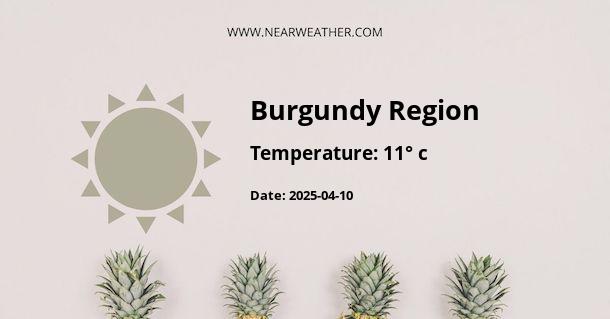Climate and Weather in the Bourgogne Region, France
The Bourgogne region, located in central France, is known for its rich history, stunning landscapes, and world-renowned wines. The region experiences a temperate climate with distinct seasonal variations. Understanding the climate and weather patterns in the Bourgogne region is essential for residents, tourists, and those planning to visit the area.
Temperature
The Bourgogne region has a relatively cool climate with moderate temperatures throughout the year. The average annual temperature in the region is around 11°C (52°F). However, there are noticeable variations between the seasons.
During the winter months (December to February), temperatures in Bourgogne can drop to an average low of 0°C (32°F) and occasionally even lower. Snowfall is not uncommon, especially in higher elevations, adding a picturesque touch to the region's landscapes.
Spring (March to May) brings milder temperatures and a gradual increase in warmth. Average temperatures range from 8°C (46°F) to 15°C (59°F) during this period, making it an ideal time to explore the region's picturesque vineyards and charming towns.
Summer (June to August) in Bourgogne is generally warm and pleasant. Average temperatures range from 20°C (68°F) to 25°C (77°F), with occasional heatwaves pushing temperatures above 30°C (86°F). The region experiences longer daylight hours, providing ample time for outdoor activities and enjoying the beautiful countryside.
Autumn (September to November) brings cooler temperatures as the region transitions into winter. Average temperatures range from 9°C (48°F) to 16°C (61°F), with vibrant foliage adding a colorful backdrop to the countryside. It's also an excellent time to sample the region's harvest produce and participate in wine tours.
Precipitation
The Bourgogne region receives a moderate amount of precipitation throughout the year. Rainfall is evenly distributed, ensuring the region's lush green landscapes and fertile soils. The average annual precipitation in Bourgogne is around 800 millimeters (31.5 inches).
Summer tends to be the driest season, with June, July, and August experiencing the least amount of rainfall. However, occasional thunderstorms can occur, providing relief from the summer heat and nourishing the vineyards.
Winter and spring are the wettest seasons in the Bourgogne region. December, January, and February receive the highest amount of rainfall, with an average of 100 millimeters (4 inches) per month. Spring showers are also common, contributing to the region's vibrant flora and fauna.
Sunshine Hours
The Bourgogne region enjoys a good amount of sunshine throughout the year. On average, the region receives around 1,800 hours of sunshine annually.
The summer months have the highest number of sunshine hours, with July and August recording approximately 8 hours of sunshine per day. This provides ample time for outdoor activities and exploring the region's charming villages, castles, and vineyards.
Winter months, on the other hand, have shorter daylight hours, with December and January recording approximately 2-3 hours of sunshine per day. However, this does not hinder the region's beauty, as the snowy landscapes and cozy atmosphere create a unique winter charm.
Wind and Climate Influences
The Bourgogne region is influenced by various climate factors, including the Atlantic Ocean, the Mediterranean Sea, and the continental climate of central France. These influences contribute to the region's unique climate and diverse landscapes.
The Atlantic Ocean brings moist air masses, resulting in mild temperatures and moderate precipitation. The Mediterranean Sea influences the region's southern parts, bringing warmer and drier conditions compared to the northern areas. The continental climate of central France further adds to the temperature variations experienced in Bourgogne.
Winds in the region are generally light to moderate, with occasional gusts during stormy weather. The prevailing winds come from the west and southwest, bringing moisture from the Atlantic Ocean. These winds play a vital role in shaping the region's climate and provide favorable conditions for viticulture.
Conclusion
The Bourgogne region in France experiences a temperate climate with distinct seasonal variations. From cool winters with occasional snowfall to warm summers with longer daylight hours, the region offers a range of weather patterns throughout the year. The moderate precipitation and ample sunshine hours contribute to the region's lush landscapes and world-renowned vineyards. Whether you're interested in exploring historical sites, indulging in wine tasting, or enjoying outdoor activities, the Bourgogne region's climate provides a suitable backdrop for a memorable experience.
A - Burgundy Region's Latitude is 47.000000 & Longitude is 4.500000.
A - Weather in Burgundy Region is 24° today.
A - Climate Conditions in Burgundy Region shows clear sky today.
A - Humidity in Burgundy Region is 36% today.
A - Wind speed in Burgundy Region is 9.29 km/h, flowing at 26° wind direction. today.
